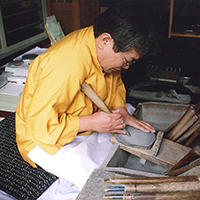KAITIKAPOU RYOUKEN
- Inkstone carving
- H 5.0 x W 20.0 x D 27.0 cm
-
$9,189
The prices of the artworks on Gallery Japan are determined by the artists themselves and are published directly on the website.
-
-
*
according to today's currency rate
-
*
shipping fees not included
-
*
When a person enjoys and admires an ink stone, that person imagines what is on his mind in that scene. I call the part where the ink stone is rubbed the "hill" or "land" and the part where the water and liquid ink is placed, "pond" or "sea" and create a scene. The image of this piece is a garden with a large pond in the middle surrounded by a garden path on the outside and a Zen-style study. The "hill" is a floating island.
| Category | Inkstone carving |
|---|---|
| Dimensions | H 5.0 x W 20.0 x D 27.0 cm |
| Materials | Homei Stone (Aichi Prefecture, Horaiji Mountain) |
| Exhibition | The 59th Japan Traditional Kōgei Exhibition |
-
Inkstone carving
Inkstones are used in brush calligraphy to grind the ink for writing characters. Inkstones are highly valued writing tools, and the process of ink grinding is regarded as a calming practice preceding calligraphic activities. First, the rough shape of the inkstone is cut out of the base rock. Next, a long-handled chisel is used to cut a flat surface where the ink will be ground and a well where the ink will gather. The final form is coated with a finish of wax or lacquer. Popular varieties of stone include Amehata slate (amehataishi) from Yamanashi prefecture, akamaishi schalstein from Yamaguchi prefecture, and hōmeiseki shale and slate from Aichi prefecture.
Hozan Nagura

As stone materials I use kimpo-seki, engan-seki, and homei-seki, collected around Kadoya, and the suzuri (ink stone) made of these three types of stone are called “Horaiji Suzuri.” Not only do I want to improve and cultivate the techniques handed down by my predecessors, and pass them on to the next generation, but I also want to develop suzuri from a simple calligraphy utensil to a work of art as a “vessel imbued with heart” that expresses the spirit and aesthetic sense of the Japanese people. I do not want to just follow a Chinese style, rather I aim to elevate the value of suzuri toward a new cultural and artistic domain of Japanese style; with this hope, I carry out my day-to-day production.

